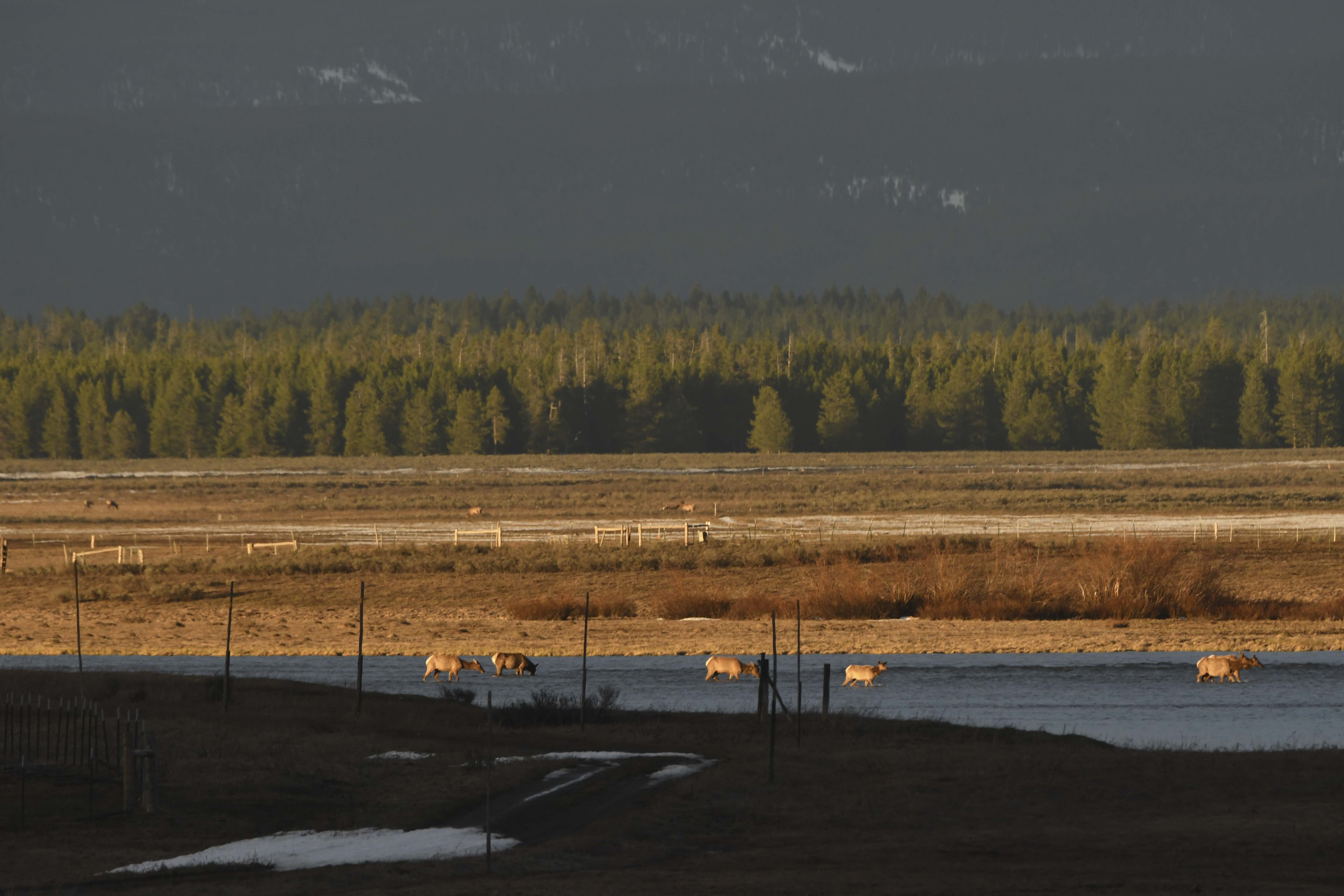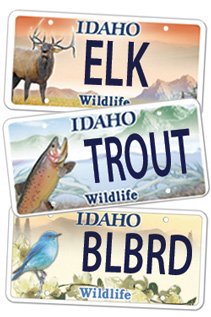Spring Migration

Elk move across Harriman State Park with a single focus determination to reach their calving grounds as soon as possible.
We saw our first elk of the season in Island Park one week ago. We were watching trumpeter swans on the far western shore of Silver Lake at Harriman State Park when my wife suddenly exclaimed, “there’s an elk!” One elk turned into 30 or more as we watched them work their way north and out of sight. When we moved to the parking lot and started on the walk to the ranch, we realized that the meadow beyond the ranch also held elk, about 175 of them, all moving north toward Last Chance and eventually wading across the Henrys Fork.
Now is the time for elk, mule deer and pronghorn to be on the move. After a brief period in the spring when they actually might move south to take advantage of greening grass lower down, these big game animals begin to push the snowline as they move to summer ranges in higher country. With the favorable conditions at lower elevations, one might wonder what the hurry is. Why not slow down and take their time like they do during fall migration, where they may only move when forced to by weather?
For big game, the answer is pretty simple. May and June are the calving and fawning months and mothers are hoping to get to their traditional birthing areas before the big event. There are several good reasons for this. First, the mother is most familiar with the resources and the terrain. She knows where to hide her calf or fawn so that she can still watch it from afar while she grazes. In familiar ground, it is also easier to spot predators that might want to make a meal of her youngster.
With migrating birds, spring migration is also a hurried event. In their case though, the race to summer homes is to secure breeding territories. With many species, males migrate before females in order to work out their differences with their neighbors before the ladies arrive. With territories decided, males can concentrate on wooing the females. Females can’t dawdle though. Though sometimes in less of a hurry, the females still have the big job of selecting a nesting site and getting a clutch of eggs laid so the process of raising a family can begin.
For some species, especially some waterfowl, the peak of the migration season through Idaho has already passed. Snow geese, for instance, made their Idaho debut in March, just as local marshes were melting out. For other birds, songbirds in particular, migration peaks in late May. Birders often state that at Camas National Wildlife Refuge near Hamer, Memorial Day weekend is the best time to see multiple species.
Shorebirds are also pushing the winter frontier. They are among the world’s greatest long-distance travelers, some going between the Arctic and Central or South America each season. They may only be in our marshes just long enough to catch their wind, then off they go. Recently we saw long-billed curlews on the Flat Ranch in Island Park and black-necked stilts, avocets, white-faced ibis and willets at Market Lake WMA near Roberts.
I have written a lot about migration because the topic fascinates me and migration is one of the best times to see lots of wildlife of all kinds. With migrating big game though, drivers should use extra caution. Animals can cross highways anywhere and a collision with one can ruin your day.
Help Idaho Wildlife
When we traveled across the state in October 2017, we visited most of the Idaho Department of Fish and Game wildlife management areas. Most of the vehicles we saw using the wildlife management areas did not have wildlife plates. Buying wildlife plates is a great way for non-hunters and hunters alike to support wildlife-based recreation like birding.
C'mon folks, let's help Idaho's wildlife by proudly buying and displaying a wildlife license plate on each of our vehicles!
See below for information on Idaho plates. Most states have wildlife plates so if you live outside Idaho, check with your state's wildlife department or vehicle licensing division for availability of state wildlife plates where you live.
And tell them that you heard about it from Nature-track.com!

Wildlife License Plates
Great news! as of 2024, there are three NEW designs for license plates. They still are bluebird, cutthroat trout and elk, but they are beautiful.
Idaho Wildlife license plates provide essential funding that benefits the great diversity of native plants and wildlife that are not hunted, fished or trapped—over 10,000 species or 98% of Idaho’s species diversity. Game species that share the same habitats (such as elk, deer, antelope, sage-grouse, salmon, trout) also benefit from these specialty plates.
No state tax dollars are provided for wildlife diversity, conservation education and recreation programs. Neither are any revenues from the sale of hunting or fishing licenses spent on nongame species. Instead, these species depend on direct donations, federal grants, fundraising initiatives—and the Idaho Wildlife license plates.
Both my vehicles have Bluebird Plates. I prefer the bluebird because the nongame program gets 70 percent of the money from bluebird plates, but only 60 percent of the money from elk and trout plates - 10 percent of the money from elk plates supports wildlife disease monitoring and testing programs (to benefit the livestock industry) and 10 percent from cutthroat plates supports non-motorized boat access.
Incidentally, in 2014, the Idaho Legislature denied the Department of Fish and Game the ability to add new plates or even to change the name of the elk and cutthroat plates (very specific) to wildlife and fish plates, a move that would have allowed for changing images occasionally and generating more revenue. It would seem that they believe that we Idahoans don't want a well funded wildlife program.
I think it is time we let the Legislature know that Idahoan support wildlife funding and that we would like to see these generic plates come to fruition.

"WOW. What a phenomenal piece you wrote. You are amazing." Jennifer Jackson
That is embarrassing, but actually a fairly typical response to my nature essays. Since The Best of Nature is created from the very best of 16 years of these nature essays published weekly in the Idaho Falls Post Register (online readership 70,000), it is a fine read. It covers a wide variety of topics including humorous glimpses of nature, philosophy, natural history, and conservation. Readers praise the style, breadth of subject matter and my ability to communicate complex and emotional topics in a relaxed and understandable manner.
Everyone can find something to love in this book. From teenagers to octogenarians, from the coffee shop to the school room, these nature essays are widely read and enjoyed.
Some of the essays here are my personal favorites, others seemed to strike a chord with readers. Most have an important message or lesson that will resonate with you. They are written with a goal to simultaneously entertain and educate about the wonderful workings of nature. Some will make you laugh out loud and others will bring a tear to the eye and warm your heart.
Readers Write:
"You hit a home run with your article on, Big Questions in Nature. It should be required reading for everyone who has lost touch with nature...great job!" Joe Chapman
"We enjoyed your column, Bloom Where Planted. Some of the best writing yet. The Post Register is fortunate to have your weekly columns." Lou Griffin.
To read more and to order a copy, click here or get the Kindle version
Copies are also available at:
Post Register
Island Park Builders Supply (upstairs)
Barnes and Noble in Idaho Falls
Harriman State Park, Island Park
Museum of Idaho
Valley Books, Jackson Wyoming
Avocet Corner Bookstore, Bear River National Wildlife Refuge, Brigham City, Utah
Craters of the Moon National Monument Bookstore, Arco, Idaho
Wildlife License Plates
Great news! as of 2024, there are three NEW designs for license plates. They still are bluebird, cutthroat trout and elk, but they are beautiful.
Idaho Wildlife license plates provide essential funding that benefits the great diversity of native plants and wildlife that are not hunted, fished or trapped—over 10,000 species or 98% of Idaho’s species diversity. Game species that share the same habitats (such as elk, deer, antelope, sage-grouse, salmon, trout) also benefit from these specialty plates.
No state tax dollars are provided for wildlife diversity, conservation education and recreation programs. Neither are any revenues from the sale of hunting or fishing licenses spent on nongame species. Instead, these species depend on direct donations, federal grants, fundraising initiatives—and the Idaho Wildlife license plates.
Both my vehicles have Bluebird Plates. I prefer the bluebird because the nongame program gets 70 percent of the money from bluebird plates, but only 60 percent of the money from elk and trout plates - 10 percent of the money from elk plates supports wildlife disease monitoring and testing programs (to benefit the livestock industry) and 10 percent from cutthroat plates supports non-motorized boat access.
Incidentally, in 2014, the Idaho Legislature denied the Department of Fish and Game the ability to add new plates or even to change the name of the elk and cutthroat plates (very specific) to wildlife and fish plates, a move that would have allowed for changing images occasionally and generating more revenue. It would seem that they believe that we Idahoans don't want a well funded wildlife program.
I think it is time we let the Legislature know that Idahoan support wildlife funding and that we would like to see these generic plates come to fruition.